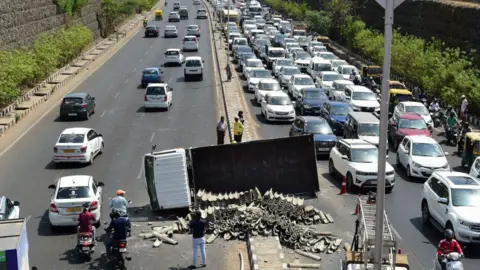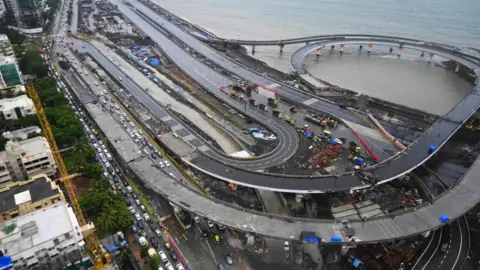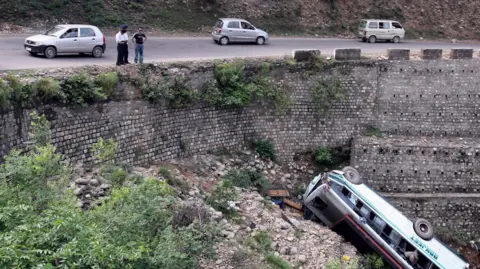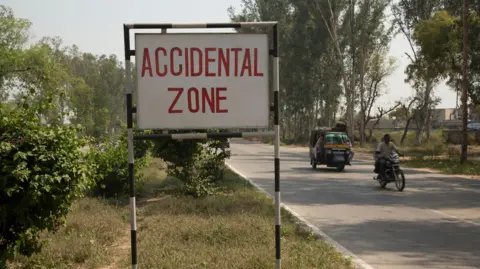Why India’s road is the deadliest road in the world

 Getty Images
Getty ImagesEvery morning, Indian newspapers are filled with reports of road accidents – riding in a bus in a mountain canyon, drunk drivers cut pedestrians, cars hit a fixed truck, and two-wheelers are knocked down by large vehicles.
These daily tragedies underscore a silence crisis: in 2023 alone, more than 172,000 people died on Indian roads, with an average of 474 deaths per day or almost every three minutes.
Although the official crash report for 2023 has not been released yet, Road Transport and Highway Minister Nitin Gadkari quoted the data Draw a grim picture During the road safety event in December.
Among the dead that year, there were 10,000 children. Accidents near schools and universities killed 10,000 people, while 35,000 pedestrians were killed. Two-wheeler drivers are also the first to be affected. Excessive speed is usually the biggest cause.
The lack of basic safety precautions has also proven deadly: 54,000 people died from not wearing helmets, while 16,000 people did not wear seat belts.
Other major causes include overload, killing 12,000 people and driving without a valid permit, which resulted in 34,000 crashes. Driving on the wrong side also leads to death.
In 2021, 13% of accidents involved drivers who have obtained a study permit or do not have a valid permit. Many vehicles on the road are old and lack basic safety features such as seat belts – not to mention airbags.
India’s chaotic traffic combination complicates this dangerous road environment.
A series of confusing user populations in India’s roads. There are motor vehicles such as cars, buses and motorcycles, competing for space, in non-motorized modes of transportation such as bicycles, rickshaws and trolleys for bicycles, trolleys for animal drawings, pedestrians and stray animals. The Kitty Hawks encroached on roads and sidewalks to sell their goods, forcing pedestrians into busy roads and complicating traffic flow.
Despite efforts and investments, India’s path remains one of the most unsafe in the world. Experts say this stems from not only infrastructure, but also from human behavior, law enforcement gaps and systemic neglect. The collapse of the road imposes a huge financial burden. Losing 3% of India’s annual GDP.
 Getty Images
Getty ImagesThere is The world’s second largest road networkAfter the United States, it spans 6.6 million kilometers (4.1 million miles). National and state highways together account for about 5% of the total network, while other roads, including the gleaming access control highway, make up the rest. An estimated 350 million registered vehicles are available.
Gadkari told the Road Safety Conference that many road accidents occurred because of the lack of respect and fear of the law.
“There are several causes of accidents, but the biggest one is human behavior,” he said.
But this is only part of the picture. Just last month, Gadkari pointed out Poor civil engineering practices – Road design flaws, unqualified buildings and weak management – and under-marking are key factors in the shockingly high road accident rates.
“The most important culprit is civil engineers…even small things like road signs and marking systems are poor,” he said.
His ministry report since 2019 Major deficiencies of highways in 59 countriesGadkari told parliament last month. of 13,795 confirmed the “black spot” that is prone to accidentsonly 5,036 have experienced long-term corrections.
Over the years, a road safety audit conducted by the Transport Research and Injury Centre (TRIPP) at the Indian Institute of Technology (IIT) Delhi has found serious flaws in India’s road infrastructure.
Take a breakdown barrier. These are to safely stop vehicles deviating from the road – without flipping them. But in many places, they are in the opposite situation.
Despite the clear height, spacing and installation standards, the reality of reality often tells a different story: a metal barrier at the wrong height, installed on a concrete base or in poor location. These defects can cause vehicles, especially trucks or buses, to stop safely.
 Reuters
Reuters“Unless installed exactly as specified, crash obstacles can do more harm than good,” Geetam Tiwari, a civil engineering professor at IIT Delhi, told the BBC.
Then there is the median of tall people-or road dividers, as locally called. On highways, the median should gently separate traffic in the opposite direction. They shouldn’t be taller than 10 cm (3.9 inches), but, audits show, many.
When a high-speed vehicle’s tire hits a vertical median, it generates heat, risk bursts, and even lifts the vehicle from the ground – causing dangerous rolling. Many medians in India simply did not design this threat to keep in mind.
A highway near the capital of Delhi is a stark example – dense settlements on both sides, with no security measures to protect residents. When high-speed traffic sounds, people are standing unsteadily on the median.
Then there is the elevated driveway. On many rural roads, repeated repaving makes the main road stand six to eight inches above the shoulder.
A sudden drop can be fatal – especially if the driver turns to avoid obstacles. Two-wheelers are the most risky, but even cars can slide, tip or flip. Experts say that as each layer is added, the danger keeps rising.
Obviously, the standards for road design in India are solid on paper – but not well executed on the ground.
“A key issue is that failing to comply with safety standards will result in minimal penalties. Contracts usually do not articulate these requirements clearly, and payments are often related to the number of kilometers built, rather than complying with safety specifications,” Tiwari said.
Minister Gardkari recently announced Ambitious plan to upgrade 25,000 km of two-lane highway to four lanes. “This will help greatly reduce accidents on the road,” he said.
Experts such as Kavi Bhalla of the University of Chicago are skeptical. Mr. Barra, who has worked in road safety in low- and middle-income countries, believes that India’s road design often mimics Western models, ignoring the country’s unique transportation and infrastructure needs.
“There is no reason to believe that road expansion will result in less traffic deaths. There is a lot of evidence that road escalation in India leads to higher traffic speeds, which is deadly for pedestrians, cyclists and motorcyclists,” he said.
 Getty Images
Getty ImagesMr. Bhalla added: “A key issue is that the new roads in India are just replicating the road design used in the United States and Europe, where the traffic environment is very different. India is trying to build American-style highway infrastructure instead of investing in American-style highway safety engineering research and crash data systems.”
In response to the escalating road safety crisis, the government is “implementing” the “5ES” strategy: road engineering, vehicle engineering, education, law enforcement and emergency care, KK Kapila of the International Highway Federation said. (According to a report by the Indian Law Commission, timely emergency medical services could save 50% of deaths in road crashes.)
Mr. Capila is helping the federal government develop road safety plans. Seven key states were asked to identify the extension of their most prone to accidents, he said. He told me that these stretching exercises “have become the safest in their state” after implementing target interventions based on the 5ES framework.
Most economists agree that building more roads is key to India’s growth, but it must be sustainable and does not prioritize the lives of pedestrians and cyclists.
“Development prices should not be borne by the poorest part of society. The only way to learn how to build such roads is to try to intervene, assess whether they improve safety, and if they don’t help, modify them and evaluate them again.” If this doesn’t happen, the roads will only get smoother and the cars will be faster – more people will die.
Follow BBC News India Instagram,,,,, Youtube, x and Facebook.





